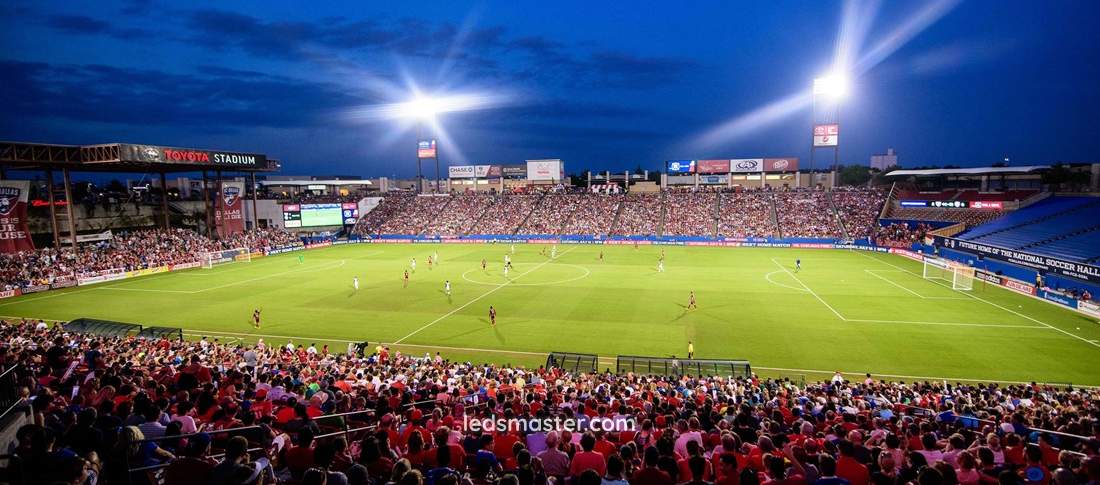
Picture a warehouse bathed in brilliant, energy-efficient light, or a sports arena glowing with unparalleled clarity and vibrancy. LEDs are not just about brightening spaces—they’re about redefining them. Join us as we explore how these innovative fixtures outshine traditional lighting, bringing brilliance and efficiency to everything from bustling commercial hubs to dynamic industrial settings.
Get your complimentary lighting design today
In the ever-evolving world of lighting, LED technology is shining brighter than ever, revolutionizing how we light up our lives and spaces. Imagine illuminating a vast warehouse, a bustling sports arena, or a chic retail store with a flick of a switch and the promise of efficiency and brilliance. LEDs have not only transformed the landscape of lighting but also redefined what we expect from our fixtures. This article takes you on a journey through the diverse world of LED lighting, comparing high bay to low bay fixtures, and revealing how LEDs outshine traditional options like metal halide. We’ll explore how these cutting-edge lights enhance everything from the thrill of a sports game to the ambiance of a commercial setting, and discover why LEDs are the preferred choice for modern illumination needs.
Table of Contents
ToggleLED (Light Emitting Diode) lighting has transformed the way we illuminate our spaces, thanks to its energy efficiency, longevity, and reduced maintenance costs. Unlike traditional incandescent or metal halide lamps, LEDs use semiconductors to produce light, making them more efficient and durable. LED fixtures are designed for a wide range of applications, each with specific features suited to different environments.
High bay and low bay LED fixtures are designed to cater to different mounting heights and lighting needs. High bay lights are ideal for spaces with high ceilings, typically above 15 feet. These fixtures are commonly used in warehouses, manufacturing facilities, and gymnasiums. High bay LEDs are engineered to provide broad, intense light to cover large areas, ensuring uniform illumination and enhancing visibility in expansive spaces.
On the other hand, low bay LED fixtures are designed for spaces with lower ceilings, generally below 15 feet. These lights are suitable for retail stores, classrooms, and office environments. Low bay fixtures focus on providing well-distributed light at closer ranges, improving visibility without causing glare or shadows.
The comparison between LED and metal halide lighting is a common one, as both have distinct advantages and disadvantages. Metal halide lamps have been a popular choice for industrial and sports lighting due to their high intensity and good color rendering. However, they are less energy-efficient compared to LEDs and have a shorter lifespan.
LED lighting offers several advantages over metal halide. Firstly, LEDs are significantly more energy-efficient, converting a higher percentage of energy into light rather than heat. This results in lower energy bills and reduced cooling costs. Secondly, LEDs have a much longer lifespan, often exceeding 50,000 hours, compared to the 10,000 to 20,000 hours typical of metal halide lamps. This longevity translates to fewer replacements and lower maintenance costs.
Another key benefit of LEDs is their instant-on capability. Unlike metal halide lights, which require a warm-up period to reach full brightness, LEDs provide immediate illumination. This feature is particularly advantageous in applications where instant light is crucial, such as in security and emergency lighting.
The versatility of LED lighting allows it to be adapted for various applications, including sports, commercial, and industrial settings. Each application has unique requirements that influence the choice of lighting fixtures.

In sports venues, LED lighting is preferred for its ability to deliver high-intensity illumination with minimal glare. High-output LED fixtures are designed to provide uniform light across large areas, ensuring that athletes and spectators experience optimal visibility. The reduced heat emission of LEDs also helps maintain comfortable temperatures in sports arenas, which can be particularly beneficial in indoor settings.
Moreover, LEDs are well-suited for high-definition television broadcasts, as they minimize flicker and offer excellent color rendering. This quality is essential for capturing clear, vibrant images on camera, enhancing the viewing experience for audiences.
For commercial spaces, LED lighting offers a range of benefits, including energy efficiency, aesthetics, and flexibility. Retail stores, office buildings, and hospitality venues often use LED fixtures to create inviting atmospheres while keeping energy costs in check. LEDs come in various color temperatures and intensities, allowing businesses to tailor their lighting to match their branding and functional needs.
The long lifespan of LEDs also means less frequent replacements and reduced maintenance, which is particularly advantageous for businesses looking to minimize operational disruptions and costs. Additionally, LED technology supports smart lighting solutions, enabling businesses to adjust lighting levels based on occupancy and time of day, further enhancing energy savings.
In industrial environments, robust and durable lighting solutions are essential. LED high bay fixtures are commonly used in warehouses, factories, and production facilities due to their ability to provide bright, consistent light over large areas. LEDs in industrial settings often feature rugged designs to withstand harsh conditions, including dust, moisture, and temperature fluctuations.
The energy efficiency of LEDs is especially valuable in industrial applications, where lighting is often in use for extended periods. Reduced energy consumption translates to significant cost savings, while the long lifespan of LEDs means fewer disruptions for maintenance and replacement.
When selecting LED lighting for various applications, several factors should be considered. These include the desired light intensity, color temperature, and fixture design. For high-traffic areas or environments requiring precise lighting control, features such as dimming capabilities and adjustable beam angles can be beneficial.
In addition, the quality of light provided by LEDs, including color rendering and uniformity, plays a crucial role in ensuring that the lighting meets the needs of the space. High Color Rendering Index (CRI) LEDs are particularly useful in settings where accurate color representation is important, such as in retail or medical facilities.
The evolution of LED lighting has significantly impacted various industries by offering energy-efficient, long-lasting, and versatile solutions. From high bay fixtures suited for industrial spaces to low bay lights for commercial environments, LEDs cater to a diverse range of applications. When comparing LED to traditional lighting options like metal halide, the advantages of LEDs—such as energy efficiency, longevity, and instant illumination—become clear. Understanding the specific needs of different settings, including sports venues, commercial spaces, and industrial facilities, allows for the selection of the most appropriate lighting solutions, ultimately enhancing functionality and reducing costs.